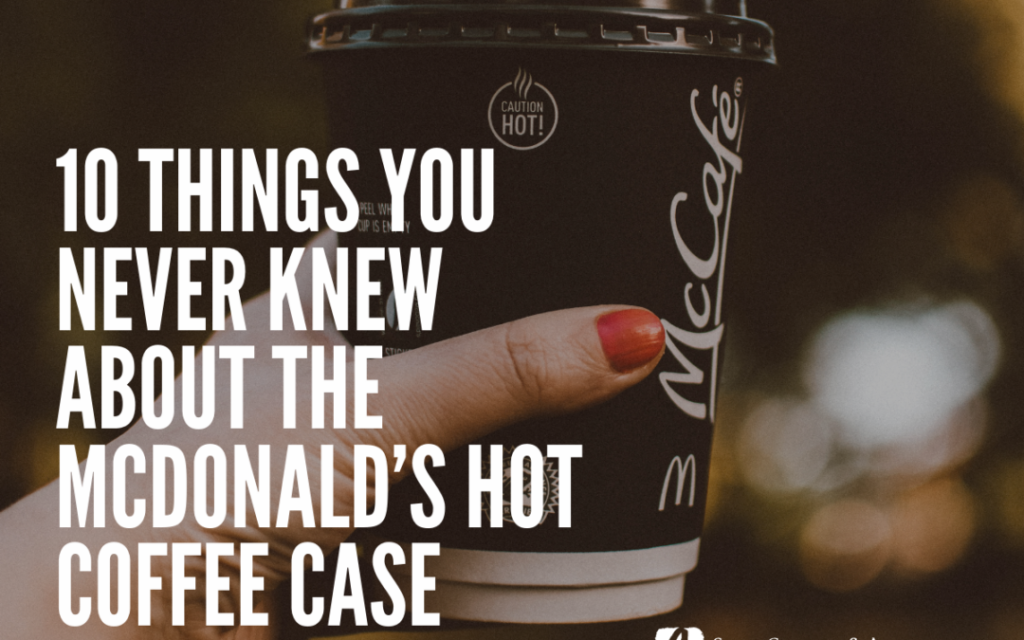10 Things You Never Knew About the McDonald’s Hot Coffee Case

A Renewed Look at the Evidence in the Infamous Case
It has been nearly 30 years since the McDonald’s hot coffee lawsuit went to court, but interest in the case remains high. People around the world dismissed the lawsuit as “frivolous” and a prime example of runaway juries. A look at the facts of the case, however, tell a different story.
Despite what most people think, plaintiff Stella Liebeck, a 79-year-old grandmother, was not driving when the coffee spilled. She was a passenger in her grandson’s car. As the car was parked, she tried to hold the cup securely between her knees while removing the plastic lid. However, the drink tipped over, spilling scalding hot coffee all over her lap, according to the Texas Trial Lawyers Association.
Here is some of the evidence presented to the jury:
- McDonald’s Knowingly Sold Their Coffee at Scalding Hot Temperatures.
It was company specification to sell their coffee at temperatures of 180 to 190 degrees Fahrenheit.
- Liquid at These Temperatures Can Cause Third-Degree Burns in Seconds.
McDonald’s coffee, if spilled, causes full thickness burns (third-degree to the muscle/fatty tissue layer) in as little as two seconds. According to the U.S. Consumer Product Safety Commission, an adult can suffer third-degree burns after being exposed to 150-degree water for two seconds.
- The Plaintiff Suffered Third-Degree Burns Across 16% of her Body.
Ms. Liebeck was hospitalized for eight days and had to undergo a variety of procedures including skin grafting and whirlpool treatment for debridement. She also suffered permanent scarring as a result of the burns, as well as disability for over two years.
- McDonald’s Knew About the Danger.
From 1982 to 1992, there were more than 700 reported claims to McDonald’s of people suffering severe injuries from their hot coffee, including burns to the genital area, perineum, inner thighs, and buttocks. It was not only adults that were injured, but also infants and children.
- McDonald’s Would Not Lower the Temperature
Despite knowing the risk of harm, McDonald’s testified – through its own witnesses – that it did not intend to turn down the heat and it did nothing to warn consumers about the dangers.
A quality-control manager testified that not only were consumers unaware of the risk, but that consumers would not anticipate such severe burns if coffee was spilled.
- McDonald’s Agreed That the Coffee Was “Not Fit for Consumption.”
At trial, the fast-food giant admitted that the drink was “not fit for consumption” as sold because of the scalding hot temperature and risk of injury to the consumer. The jury agreed, finding that the coffee was “unreasonably dangerous” and was sold in “breach of the implied warranty of fitness.”
- The Plaintiff Had Tried to Settle the Case for $20,000.
McDonald’s initially refused to settle the case. Eventually, a jury would award the plaintiff $200,000 in compensatory damages (reduced by 20% as she was found to be partially at fault for her injuries) and $2.7 million in punitive damages.
- A Judge Later Significantly Reduced the Punitive Damages.
Punitive damages were later reduced by a trial judge to $480,000; however, the parties agreed to a “post-verdict settlement.” The confidential agreement prevented further appeals, which could have taken years to resolve.
- McDonald’s Conduct Was Considered “Callous.”
The Court refused to grant McDonald’s request for a new trial. The Judge found the chain’s conduct regarding the sale of scalding hot coffee and failure to warn customers about the risk of harm if spilled was callous. For ten years, McDonald’s had seen hundreds of reports of customers receiving third-degree burns after spilling coffee, but they did nothing. Injuries included burns to the “genital area, perineum, inner thighs, and buttocks.”
- The Plaintiff’s Burns Were Substantial.
According to Ms. Liebeck’s treating physician, the 79-year-old’s burns were some of the worst scald burns he had ever seen.
THE TRUTH ABOUT HEADLINE-MAKING LAWSUITS
News headlines often spin lawsuits as being frivolous or juries as runaway. However, every case has its own facts and evidence serving as the basis for how a specific verdict or settlement is reached. The judge and jury are presented with all of the evidence, testimony, and law in a case. They are the fact-finders and decision-makers after weighing all of the evidence — evidence and facts that are often not known to the public or reported in news headlines.
The McDonald’s hot coffee case involved far more than what most people realize. There are always two sides to a story and the McDonald’s jury heard both before reaching their verdict. And, ultimately, the case was instrumental in eventually changing how coffee is served, including improved lids, insulated sleeves, and safer temperatures for consumers.

